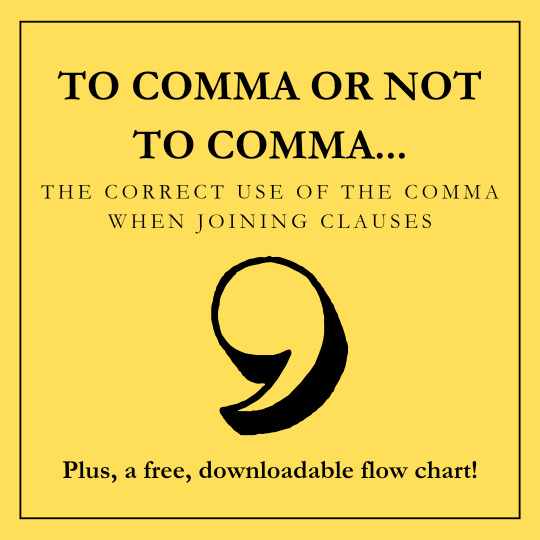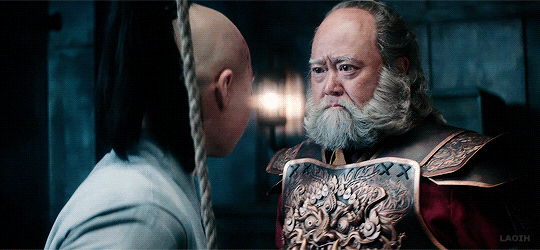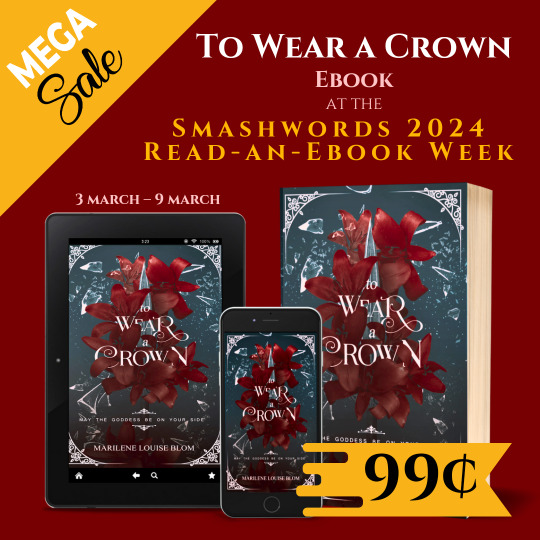Text
To Comma or Not to Comma
THE CORRECT USE OF THE COMMA WHEN JOINING CLAUSES

Should you use a comma before and? What about before yet, then or if? This is one of the trickiest rules of punctuation to apply correctly: whether to use a comma when joining clauses. But do not fear; I am here to help by providing eight tips on this very subject.
Because this is a complex topic, I’ve created a handy flow chart to assist you. You can download it for free, and I would recommend having it at hand as you read through this post.

You can also listen to this post on YouTube or read it on the Gentle Sea Editing website.
FIRSTLY, WHAT IS A CLAUSE?
A clause is a group of words that includes a verb and a subject. So, Sarah writes books is a clause because it includes a verb (writes) and a subject (Sarah). Sarah is my favorite author is a clause, but my favorite author, Sarah is a phrase, because it does not contain a verb. In today’s post, we’re focusing on clauses.
1. COMMAS WITH INDEPENDENT CLAUSES: THE GENERAL RULE
The Chicago Manual of Style (CMoS) indicates that “when independent clauses are joined by and, but, or, so, yet, or any other coordinating conjunction, a comma usually precedes the conjunction.”
Now, you might be asking, “What the hell does that mean?” Don’t worry, I had the same reaction the first time I read it.
An independent clause is a clause that makes sense on its own. It is a complete sentence. It does not depend on another clause to give it meaning. In the sentence Damon drinks blood, because he is a vampire, Damon drinks blood is an independent clause. You can remove the rest of the sentence, and it would still make sense.
Coordinating conjunctions join clauses or phrases of equal importance. So, if you want to join two clauses and show that they are on equal footing, you would use a coordinating conjunction. The list of coordinating conjunctions is represented by the mnemonic “fanboys”: for, and, nor, but, or, yet, and so.
So, according to the general rule, if you want to join two independent clauses, like Taylor wrote the impactful lyrics and Jack produced the beautiful song, with a coordinating conjunction, you should add a comma before that conjunction. Here are some examples:
Taylor wrote the impactful lyrics, and Jack produced the beautiful song.
Taylor wrote the impactful lyrics, but Jack produced the beautiful song.
Taylor wrote the impactful lyrics, so Jack produced the beautiful song.
Taylor wrote the impactful lyrics, yet Jack produced the beautiful song.
This general rule also applies to imperative sentences—sentences that give the reader an instruction, make a request, or issue a command—in which the subject (you) is not expressly stated but understood. Here are some examples:
Help Queen Charlotte climb over the wall, or tell King George to spend time with her.
Buy two tickets to Barbie, and wait for me at the corner of Cornelia Street.
It also applies to questions, for example: Do we want to save Wallachia, or are we scared of Dracula?
2. COMMAS WITH INDEPENDENT CLAUSES: THE EXCEPTION
The English language is a wonderful thing; for every rule, there are plenty of exceptions. The general rule above is no exception.
If the independent clauses you are trying to join are very short and closely connected, the comma preceding the conjunction may be omitted, unless the clauses are part of a series. (See, even the exception has an exception.)
So, if you want to join two independent clauses, like Billie sang and Finneas played the piano, with a coordinating conjunction, you can do so without a comma, because these two clauses are short and closely connected:
Billie sang and Finneas played the piano.
Billie sang but Finneas played the piano.
Billie sang so Finneas played the piano.
This exception also applies to imperative sentences where the subject (you) is omitted but understood, e.g., Get up and stand tall.
However, a comma would still have to precede the coordinating conjunction if you are joining more than two clauses. Here’s an example:
Billie sang, Finneas played the piano, and I watched the show.
So, essentially, you should follow the general rule unless you are joining two very short and strongly related independent clauses.
3. COMMAS WITH COMPOUND PREDICATES: THE GENERAL RULE
According to the CMoS, “a comma is not normally used to separate a two-part compound predicate joined by a coordinating conjunction.”
Just one question: What??? Let's break it down.
What is a predicate? It is the part of a sentence or clause that describes the action but not the subject. So, in the sentence Oppenheimer created the atomic bomb, Oppenheimer would be the subject and created the atomic bomb the predicate.
A compound predicate occurs when two or more verbs share the same subject. So, if a single subject is shared by two or more clauses, and that subject is not repeated after the first clause, you’re dealing with a compound predicate. In the sentence I gambled with Jesper and ate waffles with Nina, the subject of both the predicates gambled with Jesper and ate waffles with Nina, is I. However, I is not repeated after the first clause. So, we’re working with a compound predicate.
Therefore, the general rule is: Do not use a comma when joining a compound predicate with a coordinating conjunction. Here are some examples:
Joe broke up with Taylor Swift and divorced Sophie.
Yennefer wanted to be a mother but could not have a baby.
You should join Jinx or listen to Vi.
4. COMMAS WITH COMPOUND PREDICATES: THE EXCEPTIONS
However, a comma may be necessary to prevent misreading or confusion even if you are joining a compound predicate with a coordinating conjunction. For example, in the sentence I recognized the man who attended the concert, and fainted, the comma before and is necessary to indicate that it is the speaker who fainted, not the man attending the concert. Here are more examples:
He loved the girl who rode a dragon, and wielded shadows.
She dislikes the man who has titanium teeth, but wears Yeezy shoes.
Additionally, you should also use a comma before the word then if it is being used as shorthand for and then even if that comma separates a two-part compound predicate. So, you would write: He attended her show and then gave her a friendship bracelet or He attended her show, then gave her a friendship bracelet.
Finally, the CMoS indicates that “compound predicates of three or more parts treated as a series are punctuated accordingly.” So, if you have a single subject performing three or more actions, you would use a comma before the coordinating conjunction. For example:
Selena attended the Golden Globes, released new music, and became a billionaire.
Victoria published a book, increased her Instagram following, and announced a book tour.
5. COMMAS WITH INTRODUCTORY DEPENDENT CLAUSES
Now that we’ve gotten independent clauses out of the way, let’s talk about dependent clauses. A dependent clause cannot stand as a sentence on its own and is connected to a main, independent clause. So, in the sentence Damon drinks blood, because he is a vampire, because he is a vampire is a dependent clause, since it does not make sense on its own. Subordinating conjunctions—like if, because, whether, or when—are used to join dependent and main clauses.
According to the CMoS, “when a dependent clause precedes the main, independent clause, it should be followed by a comma.” So, when the dependent clause comes first, you separate the clauses with a comma. Here are some examples:
If Sokka trains with Suki, he will become a better warrior.
Because Kim is a successful businesswoman, she gave a lecture at Harvard.
When Nyx is older, he will train with Cassian.
6. COMMAS WITH DEPENDENT CLAUSES THAT FOLLOW THE MAIN CLAUSE
If the main clause is followed by the dependent clause, you have to determine whether the latter is restrictive or nonrestrictive.
The CMoS clarifies that a dependent clause is restrictive if it is “essential to fully understanding the meaning of the main clause.” For example, in the sentence Sokka will become a better warrior if he trains with Suki, it isn’t certain that Sokka will become a better warrior. The dependent clause if he trains with Suki adds information that is vital to understanding the main clause. Therefore, it is a restrictive dependent clause.
If a restrictive dependent clause follows the main clause, you should not place a comma before the conjunction. Here are two examples:
Nyx will train with Cassian when he is older.
Kourtney wasn’t mad because of the fashion show; she was mad because of the timing.
A dependent clause is nonrestrictive if it is not essential to the meaning of the main clause. For instance, in the sentence Margot is a good actress, whether you like her or not, the dependent clause whether you like her or not can be omitted without changing the meaning of the main clause.
If a nonrestrictive dependent clause follows the main clause, the subordinating conjunction should be preceded by a comma. Here are two examples:
I’d like to watch Mean Girls, if you don’t mind.
He arrived hours later, when the movie was already over.
However, sometimes this can be a tricky differentiation to make. Take the sentence Kourtney wasn’t mad because of the fashion show. Without the comma, Kourtney is still mad, just not about the fashion show. Add a comma before because, and the fashion show becomes the reason she’s not mad. The CMoS’s advice? “If in doubt, rephrase.”
7. COMMAS WITH INTERVENING DEPENDENT CLAUSES
When a dependent clause is located between two other clauses, meaning that the two conjunctions are right next to each other, the conjunctions don’t have to be separated by a comma. Here are some examples:
Violet tried to decipher the journal for days, but if Dain had not given her advice, the truth would have remained concealed.
Zuko stood up for the soldiers, and when his father ordered him to fight back, he refused.
They decided that if Percy didn’t return the lightning bolt, he wouldn’t see his mother.
Technically, there’s nothing wrong with adding a comma in between these conjunctions. In fact, it might even be preferred in certain cases for emphasis or clarity.
8. COMMAS WITH RELATIVE CLAUSES
Finally, let’s look at relative clauses. A relative clause provides information about a noun. For instance, in the sentence The book that she wrote years ago was published this year, that she wrote years ago is a relative clause, because it tells us more about the noun (book).
According to the CMoS, “restrictive relative clauses are never set off by commas from the rest of the sentence.” As with dependent clauses, a relative clause is restrictive if it provides information that is crucial to understanding the rest of the sentence. In the example above, the reader wouldn’t have known which book the author is referring to without the relative clause that she wrote years ago, so no commas are used. Restrictive relative clauses are usually introduced by the pronouns that, who, whom, or whose. Here are some examples:
I prefer to support politicians who stand up against genocide.
The joke that he made at the Golden Globes was sexist.
The author whose work I like the most has just released a new book.
This rule applies even when these pronouns are omitted:
The movie I just watched won an Academy Award.
The people we follow on social media have a big impact on our lives.
A nonrestrictive relative clause, on the other hand, is not essential to the identity of the noun to which it refers. In the sentence Sarah’s House of Flame and Shadow, which I finished last night, is a great book, the relative clause which I finished last night can be omitted without changing the meaning of the sentence. So, it is nonrestrictive. Nonrestrictive relative clauses are set off from the rest of the sentence by commas. These clauses are usually introduced by which, who, whom, or whose. Here are some examples:
I prefer to read about scholarly characters, who are less likely to be ignorant.
Madelyn Cline, whose most famous movie is Glass Onion, was seen with Pete Davidson.
The talk show, which recently featured Sydney Sweeney, has celebrities eating spicy food as they answer questions.
So, to sum up (TL; DR):
• If you want to join two independent clauses with a coordinating conjunction, you should add a comma before that conjunction unless the two clauses are short and closely connected.
• Do not use a comma when joining a compound predicate with a coordinating conjunction unless:
o a comma is necessary to prevent a misreading;
o then is being used as shorthand for and then; or
o a compound predicate of three or more parts is being treated as a series.
• If a dependent clause precedes a main, independent clause, add a comma after the dependent clause.
• If a restrictive dependent clause follows a main clause, do not add a comma before the subordinating conjunction.
• If a nonrestrictive dependent clause follows a main clause, you should add a comma before the subordinating conjunction.
• When a dependent clause is located between two other clauses, meaning that the two conjunctions are right next to each other, the conjunctions don’t have to be separated by a comma.
• A restrictive relative clause is not set off with commas.
• A nonrestrictive relative clause is set off with commas.
There you have it; those are the rules for comma usage when joining clauses, at least in terms of the CMoS. In the wise words of Neil Gaiman: “It’s that easy, and that hard.”
For professional editing and proofreading services, head on over to gentleseaediting.com

34 notes
·
View notes
Text
Tips for Self-Editing Your Novel
youtube
#writing#writeblr#writers#write#writer#writing advice#amwriting#writing tips#writerblr#writing community
13 notes
·
View notes
Text
Tips for Self-Editing Your Novel
youtube
#writing#writeblr#writers#write#writer#writing advice#amwriting#writing tips#writerblr#writing community#Youtube
13 notes
·
View notes
Text
How to Create a Compelling Author Bio
youtube
#writing#writeblr#writers#write#writer#writing advice#amwriting#writing tips#writerblr#writing community
14 notes
·
View notes
Text
How to Create a Compelling Author Bio
youtube
#writing#writeblr#writers#write#writer#writing advice#amwriting#writing tips#writerblr#writing community#Youtube
14 notes
·
View notes
Text













"We know what it means to be on our own."
AVATAR: THE LAST AIRBENDER (2024)
1K notes
·
View notes
Text

Get the TWAC ebook for only USD0.99 at Smashwords this week!
5 notes
·
View notes
Text
[repeating to myself in the mirror] it is fine to write serviceable workaday sentences. not all of them have to be the God-King of Sentences, beautiful in structure, deft in word choice, gilded in metaphor, etc. sometimes a guy has to get from one side of a room to the other.
17K notes
·
View notes
Text
How to Write a Love Interest
youtube
#writing#writeblr#writers#write#writer#writing advice#amwriting#writing tips#writerblr#writing community
18 notes
·
View notes
Text
How to Write a Love Interest
youtube
#writing#writeblr#writers#write#writer#writing advice#amwriting#writing tips#writerblr#writing community#Youtube
18 notes
·
View notes
Text
hofas bonus chapter masterlist
ruhn and lidia
bryce and hunt
bryce and danika
ember and randall
bryce, nesta, and azriel
812 notes
·
View notes
Text
Marketing Tips for Self-published Authors
youtube
#writing#writeblr#writers#write#writer#writing advice#amwriting#writing tips#writerblr#writing community
23 notes
·
View notes
Text
Marketing Tips for Self-published Authors
youtube
#writing#writeblr#writers#write#writer#writing advice#amwriting#writing tips#writerblr#writing community#Youtube
23 notes
·
View notes
Text
Tips for Writing Fantasy Romance
youtube
#writing#writeblr#writers#write#writer#writing advice#amwriting#writing tips#writerblr#writing community
13 notes
·
View notes
Text
Tips for Writing Fantasy Romance
youtube
#writing#writeblr#writers#write#writer#writing advice#amwriting#writing tips#writerblr#writing community#Youtube
13 notes
·
View notes
Text
child handling for the childless nurse
My current job has me working with children, which is kind of a weird shock after years in environments where a “young” patient is 40 years old. Here’s my impressions so far:
Birth - 1 year: Essentially a small cute animal. Handle accordingly; gently and affectionately, but relying heavily on the caregivers and with no real expectation of cooperation.
Age 1 - 2: Hates you. Hates you so much. You can smile, you can coo, you can attempt to soothe; they hate you anyway, because you’re a stranger and you’re scary and you’re touching them. There’s no winning this so just get it over with as quickly and non-traumatically as possible.
Age 3 - 5: Nervous around medical things, but possible to soothe. Easily upset, but also easily distracted from the thing that upset them. Smartphone cartoons and “who wants a sticker?!!?!?” are key management techniques.
Age 6 - 10: Really cool, actually. I did not realize kids were this cool. Around this age they tend to be fairly outgoing, and super curious and eager to learn. Absolutely do not babytalk; instead, flatter them with how grown-up they are, teach them some Fun Gross Medical Facts, and introduce potentially frightening experiences with “hey, you want to see something really cool?”
Age 11 - 14: Extremely variable. Can be very childish or very mature, or rapidly switch from one mode to the other. At this point you can almost treat them as an adult, just… a really sensitive and unpredictable adult. Do not, under any circumstances, offer stickers. (But they might grab one out of the bin anyway.)
Age 15 - 18: Basically an adult with severely limited life experience. Treat as an adult who needs a little extra education with their care. Keep parents out of the room as much as possible, unless the kid wants them there. At this point you can go ahead and offer stickers again, because they’ll probably think it’s funny. And they’ll want one. Deep down, everyone wants a sticker.
280K notes
·
View notes
